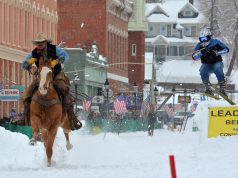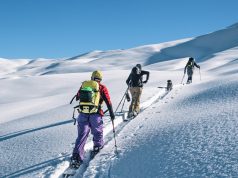
Bill Lee is laughing.
“If they don’t want to run, you’re not going to finish the race,” he says and laughs some more. “It doesn’t matter if you’re an elite athlete or not. It’s about the burro.”
That’s the crux when it comes to burro racing, a sport that makes a team from a runner who races alongside a burro. You can run as hard and as fast as you want, but if your partner — the burro — decides to take a break, there’s not too much you can do about it. Still, according to Lee, the other side of the equation is almost rougher.
“I may not be a seven-minute mile runner,” he says. “But if the burro decides that’s the pace we’re going to go, then I’ll be doing seven-minute miles.”
Lee is the president of the Western Pack Burro Association. The organization was founded to promote the sport of burro racing, and runs the go-to website for aficionados of the sport.
“We’re not a governing body,” Lee says.
“We promote burro racing and the traditions of the sport.”
The association also publicizes Colorado burro racing’s summer event schedule, posts race results and provides newcomers to the sport with the advice and support that they need to get involved. There are rules (no whips or prods for the burros), racing 101 tips (moderation in all things, including moderation) and pictures of events, including the legendary photo finish at the Buena Vista Gold Rush Days in 2004 when Bobby Lewis racing with Wellstone and Barb Dolan racing with Chugs finished in a neck-and-neck tie for first place.
Burro racing probably won’t be coming to prime time on ESPN soon, but that doesn’t mean that the sport isn’t alive and well in Colorado. The origins of racing are debated among enthusiasts, with some claiming that the sport started when two gold miners found the same vein and then raced back to town to stake their claim.
Others say the events started as drunken bets placed in the rough and tumble taverns of mining towns. But regardless of burro racing’s true provenance in frontier days, the consen sus is that modern burro racing started in the late 1940s when a $500 purse — big money for those days — headlined a 1949 race from Leadville to Fairplay.
Today, the Colorado’s summer burro racing season is composed of six events over three months, including the Triple Crown events held in Fairplay, Leadville and Buena Vista. These elite races feature longer, tougher courses, and complement shorter events like a July 14 date in Idaho Springs. The Idaho Springs race, held over a 4- to 6-mile course, is a great way to break into the sport, but newcomers should be warned. Nothing you’ve learned in any other sport will prepare you for the joy, frustration, intensity and camaraderie that is burro racing.
“It’s crazy,” says Boulder resident and burro racer Brian Metzler. “You can be having a great race, and then you’ll come to a bridge, and the burro will decide that it doesn’t want to cross the bridge and you’ll end up finishing last.”
“It’s an ego-busting sport,” Lee says. “Elite runners can get really frustrated. It takes time and effort to work with burros.”
But, Lee says, “that’s part of the satisfaction for many of the runners.”
“A few of us old timers will pull a rabbit out of the hat,” he says. “We’ll have a good burro and have a good day. It’s all a matter of working with the burro. The satisfaction of knowing that you can work as a team, and do better than each one of you would have done alone.”
“Just getting to the race is a victory!” says Highlands Ranch resident and burro racer Brad Wann with a laugh. “When you race with a burro, you’re just along for the ride.”
Burros are smart. They’re also tough. And they like to be outside, running, chilling out or, sometimes, frustrating their human teammates. They even like to compete.
“They’re like kids,” says Lee.
“Remember when you and your friends were young, and you’d race to the end of the street? Burros do that kind of thing.”
Burros, for the uninitiated, are don keys.
First brought to the Americas by Christopher Columbus, they were used extensively in Colorado by miners, who valued them for their endurance and ability to easily traverse the toughest terrain in the Rockies. With the decline of the gold and silver booms, their use waned. However, Colorado remains the epicenter of burro racing.
With their ability to travel more than 60 miles in a day and go two days without water, burros are tougher than their human teammates. But they’re more fickle as well. The key to racing with burros, according to veterans like Lee and Wann, is to build a relationship with the animal. Burro racing is, after all, a team event, and successful teams — the ones that finish the race — are the ones that work together.
“A lot of people say donkeys are stubborn, but they’re cautious,” says Lee. “You have to develop a partnership and then they’ll do anything for you.”
“The way to get started is to train with an animal, to go on long hikes,” Wann says. “You’re learning your partner and your partner is learning you.”
“These hikes bring bonding,” Wann says. “That’s what makes this thing so intriguing. You have people who have been doing this almost 40 years. Once it gets in your blood, it’s hard to walk away from it.”
The highlight of the burro racing season is the Triple Crown, three grueling (for the humans, not so much for the burro) events held in Fairplay, Leadville and Buena Vista at the end of July. The Fairplay event is also the World Championship Pack Burro Race and the highlight of the town’s Burro Days (burrodays.com), which celebrates the contributions that burros made to Colorado mining history, and which benefits Park County RE-2 schools.
For rookies, however, Idaho Spring’s July 14 race is an ideal venue to try racing and to see what it’s all about.
“The Idaho Springs race is nice in that it’s short enough that you can have some trial and error,” Wann says. “This is a where you can get your feet wet. You go up a mountain, back down the mountain, and it’s less than one hour.”
The Idaho Springs venue is also ideal for spectators. The short course makes for a high-speed event, with a lot of excitement at the finish.
“You’ll see some huge action,” Wann says. “Anyone could win, that’s what’s so great. This is a great race to see. You’ll see a piece of history, and it is really cool to see the determination of the burros. It is an amazing sight.”
Upcoming events:
• Idaho Springs, July 14: Close
to Boulder, with a short fast course and excellent spectating
opportunities, this is an event you won’t want to miss. Information:
Bill Lee, 720-234-8200
• Western Pack Burro Association: The
place for all things burro racing, including race schedules, rules and
how to find a burro teammate for your next race. Information:
packburroracing.com
• World Championships: The
first leg of the Triple Crown features a 29-mile course that traverses
the 13,000-foot Mosquito Pass, start and finish in Fairplay. Held on
July 29. Information: burrodays.com
• Boom Days: Second leg of the Triple Crown held in Leadville, with a 22-mile course. Held on Aug. 5. Information: leadvilleboomdays.com
• Gold Rush Days: Final
leg of the notorious Triple Crown with a 12-mile course that includes
crossing a suspension bridge over the Arkansas River. Held in Buena
Vista on Aug. 12. Information: Karen Thorp, 719-221-2424
Respond: [email protected]














